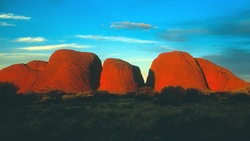Uluru

Uluru is the largest monolith in the world made up of a single piece of arkosic sandstone, which extends to 5 kilometres beneath the desert surface. Uluru rises 348 metres above the ground, and has a total circumference of 9.4 kilometres. Uluru captivates and inspires people internationally with over 350,000 tourists annually, with its unique fiery presence at sunrise and sunset.
Kata Tjuta

Meaning “many heads” in Aboriginal language, Kata Tjuta or Mount Olgas is a group of large rock dome formation consisted by a group of over than 36 large rock domes made up of granite, basalt, and sandstone. Kata Tjuta is located 42 kilometres west of Uluru, and the tallest rock dome is 546 metres high. Kata Tjuta is a massive system of gorges and valleys that allows people to walk around and soak in the quiet and spiritual environment. To the Anangu people, it is of equal significance as Uluru.
Arkose

Uluru is dominantly composed of a type of sandstone called ‘Arkose’, coarse-grained and commonly found in granite. Arkose is unique for its significant composition of rock fragments to cause the sandstone to be course, each grain approximately 2-4 mm in diameter.
The type of Arkose which composes Uluru is consisted of approximately 50% feldspar, 25 % quartz and up to 25% rock fragments.
One advantage to being almost entirely composed of Arkose is its special qualities – It changes colour under the sunlight. This gives Uluru a colour of ‘flaming red’ at sunset and ‘brilliant gold’ under the sunrise. Interestingly, Kata Tjuta is composed of a separate material to Uluru, being dominantly composed of Conglomerate.
The type of Arkose which composes Uluru is consisted of approximately 50% feldspar, 25 % quartz and up to 25% rock fragments.
One advantage to being almost entirely composed of Arkose is its special qualities – It changes colour under the sunlight. This gives Uluru a colour of ‘flaming red’ at sunset and ‘brilliant gold’ under the sunrise. Interestingly, Kata Tjuta is composed of a separate material to Uluru, being dominantly composed of Conglomerate.
